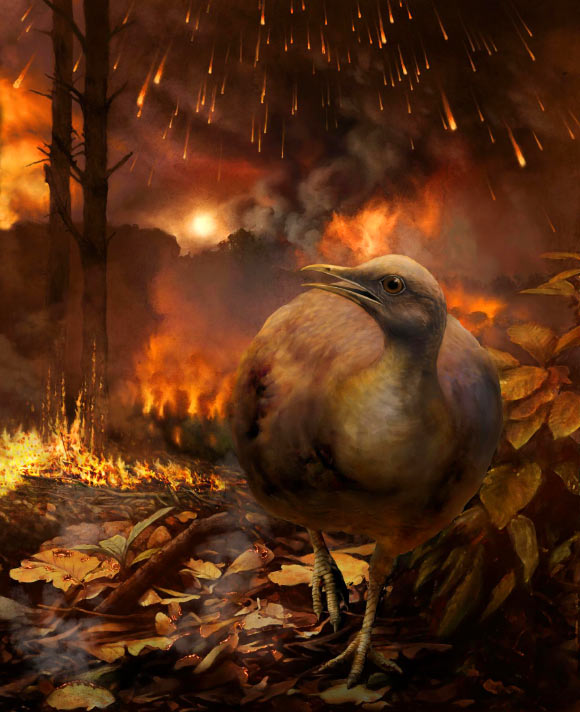Ground-dwelling birds survived while their close, tree-dwelling relatives went extinct during the end-Cretaceous mass extinction event, caused by the impact of an asteroid off the Mexican coast some 66 million years ago, according to new research.

A hypothetical surviving bird lineage — small-bodied and specialized for a ground-dwelling lifestyle — flees a burning forest in the aftermath of the asteroid strike. Image credit: Philipp M. Krzeminski.
An international research team led by Dr. Daniel Field of the University of Bath pieced together evidence from the plant fossil record and ecology of ancient and modern birds, and found that the only birds to survive the end-Cretaceous extinction (also known as the Cretaceous-Paleogene, Cretaceous-Tertiary or K-Pg extinction) lived on the ground.
“We drew on a variety of approaches to stitch this story together. We concluded that the temporary elimination of forests in the aftermath of the asteroid impact explains why arboreal birds failed to survive across this extinction event,” Dr. Field said.
“The ancestors of modern arboreal birds did not move into the trees until forests had recovered from the extinction-causing asteroid.”
“Looking at the fossil record, at plants and birds, there are multiple lines of evidence suggesting that the forest canopies collapsed. Perching birds went extinct because there were no more perches,” added co-author Dr. Regan Dunn, a paleontologist at the Field Museum in Chicago.
“This study provides a large-picture, ecosystem-wide explanation for why certain groups did well after the extinction and set the stage for modern birds,” said co-author Dr. Tyler Lyson, a paleontologist at Denver Museum of Nature & Science.
“It is fascinating to me that an event that happened 66.02 million years ago shaped the modern world, and we’re able to see this through molecular data thanks to technology that wasn’t even around 10 years ago.”
The team’s analysis of the plant fossil record confirmed that global forests collapsed in the wake of the asteroid’s impact.
“Our study examined the fossil record from New Zealand, Japan, Europe and North America which showed there was a mass deforestation across the globe at the end-Cretaceous boundary,” explained co-author Dr. Antoine Bercovici, a paleobotanist at Smithsonian Institution.
“This was followed by a mass colonization of so-called ‘disaster plants,’ such as ferns, whose spores were able to survive the asteroid hit and germinate rapidly to fill the habitats left empty by the extinction of the trees.”
The scientists then used the evolutionary relationships of living birds and their ecological habits to track how bird ecology has changed over the course of their evolutionary history.
Those analyses showed that the most recent common ancestor of all living birds — and all bird lineages passing through the end-Cretaceous extinction event — likely lived on the ground.
By contrast, many birds that lived at the end of the age of dinosaurs exhibited tree-dwelling habits. However, those species didn’t survive the extinction event to give rise to any known modern-day birds.
The ancestors of modern tree-dwelling birds did not move into the trees until forests had recovered from the extinction-causing asteroid.
“Today, birds are the most diverse and globally widespread group of terrestrial vertebrate animals — there are nearly 11,000 living species,” Dr. Field said.
“Only a handful of ancestral bird lineages succeeded in surviving the mass extinction event 66 million years ago, and all of today’s amazing living bird diversity can be traced to these ancient survivors.”
The findings, published in the journal Current Biology, illustrate the fundamental influence of major events in Earth’s history on the evolutionary trajectories of major groups of organisms.
In the future, the research team plans to continue to explore the precise timing of forest recovery and the early evolutionary radiation of birds.
_____
Daniel J. Field et al. Early Evolution of Modern Birds Structured by Global Forest Collapse at the End-Cretaceous Mass Extinction. Current Biology, published online May 24, 2018; doi: 10.1016/j.cub.2018.04.062







